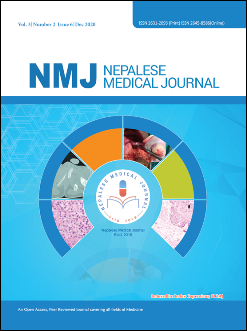Clinical Spectrum of Infertile Couple: a Retrospective Study at Teaching Hospital
DOI:
https://doi.org/10.3126/nmj.v3i2.35117Keywords:
Anovulation; Asthenozoospermia; Infertility; ObesityAbstract
Introduction: Infertility has been rising steeply as the prime health issue among women around the world these days. This study aims to investigate the causes, hormonal profi le, and clinical spectrum of infertility.
Materials and Methods: This is a descriptive cross-sectional study conducted throughout a one year duration in an infertility clinic. The couples meeting the inclusion criteria were included and a pre-formed proforma was used to collect the data regarding history, examination, and investigations.
Results: A total of 118 infertile couples were analyzed. The mean age of the females was 28.3±4.5 years. There were 72.1 %cases of primary infertility and 27.9 %of secondary infertility. Regarding obesity status,35.5% were overweight and 15.2 % were obese. Thirty-one (26.2%) males were smokers, 41 (34.7%) used to consume alcohol, and 14 (11.8%) had a habit of chewing tobacco. Among the different fi ndings of semen analysis, 21.1% asthenozoospermia, 9.3% oligoasthenozospermia,7.6% oligospermia, 1.6% azoospermia. Female factor accounted for 45.3%, the malefactor for 28% and in 19.3% the defi nite factor was not determined. The ovulatory disorder was diagnosed in 38.6% of females and hysterosalpingography (HSG) revealed that around 10% had a unilateral block and 1.7% had a bilateral block.
Conclusions: Infertility is becoming a global issue affecting a signifi cant number of young couples. About forty-six percent were female aging more than thirty years. The female factor for infertility was more common than the male factor among which ovulatory disorder was the commonest one. Asthenozoospermiawas the commonest abnormal fi nding on semen analysis in a male partner.
Downloads
Downloads
Published
How to Cite
Issue
Section
License
This license enables reusers to distribute, remix, adapt, and build upon the material in any medium or format, so long as attribution is given to the creator. The license allows for commercial use.
Copyright on any article published by Nepalese Medical Journal is retained by the author(s).
Authors grant Nepalese Medical Journal a license to publish the article and identify itself as the original publisher.
Authors also grant any third party the right to use the article freely as long as its integrity is maintained and its original authors, citation details and publisher are identified.




